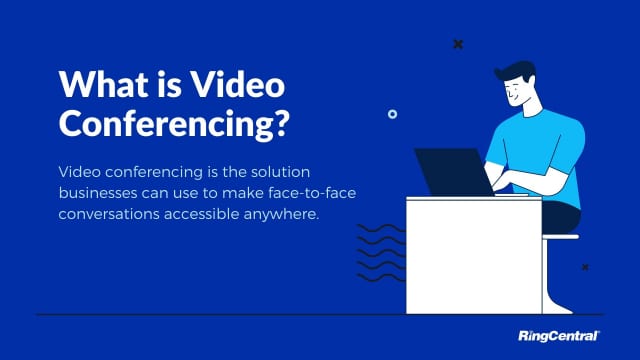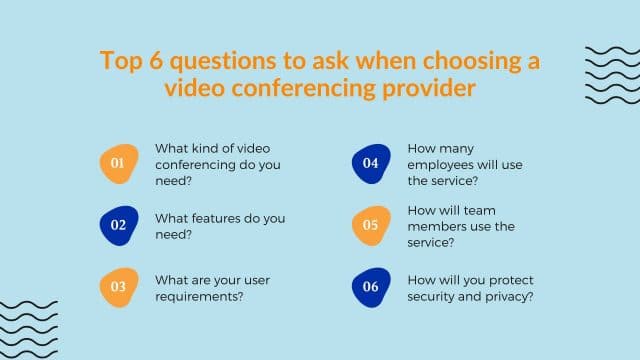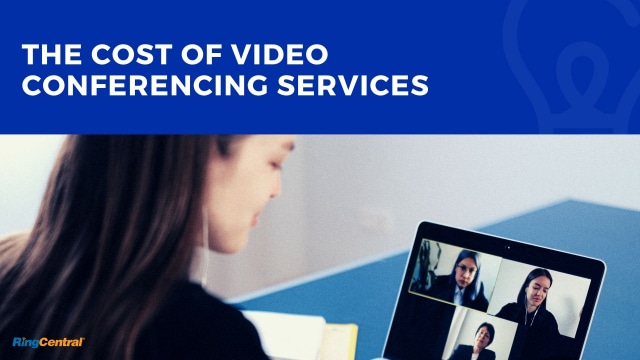The Complete Buyer’s Guide to Video Communication
The use of video conferencing technology has grown at an astronomical pace in recent years. Companies have discovered that with the right video technology, they don’t need to rely on expensive and time-consuming commutes or travel to connect with shareholders and colleagues. Video bridges the gaps in location in an instant, bringing face-to-face conversation into the virtual world.
In 2020, video conferencing has encountered one of its biggest growth spikes to date, with video apps hitting a record 62 million downloads in March. Reports also suggest that by 2021, 80% of all the internet traffic on the web will be dedicated to video.
Replacing exhausting travel experiences and conference calling with the intimate and engaging platform of video is an excellent way to accelerate business results. However, before you can tap into the benefits of video conferencing, you need to learn how to choose the right equipment for your team. That’s what we’re here to help with.
In 2020, video conferencing has encountered one of its biggest growth spikes to date, with video apps hitting a record 62 million downloads in March. Reports also suggest that by 2021, 80% of all the internet traffic on the web will… Click To Tweet
What is video conferencing?

Video conferencing is the solution businesses can use to make face-to-face conversations accessible anywhere. Through a webcam, microphone, and the right software, you can instantly launch an intimate discussion between two people located on opposite sides of the globe.
The definition of video conferencing goes beyond simply conveying images and audio from one environment to another or having video chats. This solution is about eliminating geographical boundaries so that everyone from remote workers to contractors and customers can stay connected.
A few years ago, video conferencing was an impossible dream for many smaller companies. Conferencing equipment was bulky, complicated, and expensive, meaning that only the largest brands could afford to invest.
However, as the marketplace evolved and cloud video conferencing emerged, companies began to discover a cheaper and more efficient way to maintain the human element of face-to-face communication. According to Transparency Market Research, video conferencing as a market will grow to a value of $11.56 (£9.34) billion by the end of 2027.
Whether you’re using a plug-and-play huddle room in the office, equipped with everything from a conference calling machine to wide-frame video cameras, or you’re connecting over the web, video conferencing is more accessible than ever.
Evaluating your video conferencing needs
Video-conferencing equipment has emerged as a must-have for businesses around the world, particularly as remote working becomes more popular. As part of a comprehensive collaborative experience, combined with instant messaging and content sharing, video keeps people connected.

However, there’s more to unlocking the advantages of video conferencing than just plugging in a webcam. Business leaders will need to think carefully about their needs and expectations before investing in new equipment.
If you want to see for yourself why 94% of businesses say that using video increases their productivity levels, here are some of the points you’ll need to consider.
Top 6 questions to ask:
-
What kind of video conferencing do you need?
Video conferencing solutions come in a wide range of formats, designed to suit different business needs. There are full meeting room kits that you can use to outfit spaces in your business with everything they need for immersive video sessions.
These kits can even include virtual whiteboarding equipment, and tools for content sharing too. Alternatively, you might embrace video conferencing on the cloud. This means that you can access the software you need anywhere, using the hardware that your team already has.
-
What features do you need?
Video conferencing tools can come with access to a range of capabilities that support and enhance your team. For instance, you might need recording solutions that allow you to share meetings with people who couldn’t attend.
You might also need video tools that integrate with file and screen-sharing capabilities to add context to your meetings. Some video-conferencing software also integrates with other tools for collaboration, like instant-messaging services.
-
What are your user requirements?
Do you need a video service that can support employees all around the globe? Will the data gathered by your video systems need to remain in a specific data centre location for compliance purposes? On top of that, what kind of devices will your employees be using to connect? Will they need to have access from their smartphones and tablets, as well as computer screens?
-
How many employees will use the service?
Are you introducing video conferencing technology as a solution for just your remote workers and essential employees? Or do you want to make sure that everyone on your team, including your front-line workers, can access the same technology? The number of employees that you have using your service will make an impact on your tech choices.
-
How will team members use the service?
Video conferencing tools can deliver a range of different interactions. You might need something that supports one-on-one conversations, as well as group calls, and even webinars or training sessions with a single speaker and a vast audience. Having access to video-conferencing software that gives you a range of ways to collaborate is a great way to boost productivity.

-
How will you protect security and privacy?
Will your video software be encrypted? How can you ensure that your team members stay defended, even when they’re logging in from external devices outside of your office?
The best way to ensure that you have everything you need for your video conferencing investment is to start with a thorough evaluation of your company and your team’s needs, then work backward. Figure out what kind of service is essential to you, and how you’re going to use the technology, then look for a vendor that can give you the support and ease of use you need to drive adoption.
The cost of video conferencing services

Just like most business investments, the amount you spend on your video conferencing technology will depend on the level of functionality that you need.
Many of the leading video-conferencing options come with free trials, so you can put the functionality to the test before you invest in anything long-term.
Although there are free tools out there that can allow for quick and simple conversations, it’s important to remember that most of these solutions don’t have the tools required to support a business. Choosing a free video-conferencing service usually means compromising either on essential features or giving up security and privacy.
Typically, you will need to pay a premium monthly cost for your video technology if you want to ensure that it suits your business. However, the good news is that the cost savings that you earn from video conferencing can help the technology to pay for itself. Remember, embracing video means that you can eliminate unnecessary travel costs.
Additionally, because more of your team members will be able to work from home, you’ll also be able to cut down on the costs of office overheads for the people in your team. The best video conferencing tools do come with a price, but they’re often worth the cost.
The types of video conferencing solutions

Once you’ve thought about what you need from your video conferencing solutions, and you’ve decided on a budget, you can begin to consider some of the different types of product available. There are a few different choices out there, including:
-
Meet me services
Otherwise known as web conferencing tools, these services allow you to set up meetings with people inside and outside of your organisation. All you need to do is get a dedicated link and PIN code and send it to the people you want to meet.
Once the other person clicks on the link, they’ll be able to jump into the meeting immediately. You can also access services that allow people to dial into meetings if they don’t have an internet connection.
-
Traditional conferencing
Traditional video conferencing is a term used to refer to the hardware-reliant video conferencing experiences that businesses used to rely on. Before the cloud, these expensive services allowed companies to build meeting rooms out of board rooms, using costly equipment and technology.
These meeting rooms require a lot of maintenance and commitment, which made them suitable mainly for large companies.
-
Cloud video conferencing
Cloud-based video conferencing is rapidly emerging as the most valuable form of video for today’s transforming businesses. The experience is based on the cloud, so anyone with an account can log in wherever they are, using any device.
These tools can also integrate with other leading collaboration solutions for instant messaging, screen sharing, and more, so that you can drive better connections between members of your team.
How to choose the right video conferencing service

With a deeper understanding of video conference technology and how it works, you’re now ready to start evaluating some of the options in the market. Although your choice of the ideal video solution will depend on your needs and your business, there are a few factors that all companies will need to consider. Let’s take a look.
1. Video conferencing quality
The first thing to think about is the kind of video quality you need to enhance your team’s productivity. The potential of video meetings is constantly growing, with access to everything from 4K video, to the future promise of AR and VR. To ensure that you get the best quality of conference for your team and your customers, make sure that you’re working with a vendor that can deliver a consistent HD experience.
Remember, for a video conference to go well, it’s not just the picture that needs to be clear, but the audio too. Don’t choose a high-definition video conferencing company that compromises on audio quality, or your meetings will suffer.
2. Think about feature-set
Once you’ve got the foundations of your video conferencing tools right, you can begin to build on that framework with extra functionality and tools. Many of the leading video conferencing services available today go beyond providing a basic meeting connection.
These software solutions can also include essential tools for collaboration, like file sharing, screen sharing, and instant messaging. At the same time, if you work with a business-oriented vendor, you can also expect access to things like call recording and reporting too.
Think about the kind of tools that could help your team members to perform at their best. Do they need to share screens when discussing projects with coworkers? Will it be essential to access recordings so that you can share the same information with people who might not have been able to attend a meeting?
3. Think about the future
The demand for video chats is growing, and the popularity of this service is unlikely to go away any time soon. With that in mind, it’s worth thinking about not just the functionality that you need now, but what you may also need in the future too. For instance, would it be helpful to have the option to implement AI assistants and analytics into your video meetings?
An assistant that can record and transcribe conversations for your team will make tracking information easier. Additionally, analytics would show you how your employees are using your meeting tools. Working with a vendor that has their finger on the pulse of what’s to come in video conferencing software could be valuable to prepare your company for the future.
4. Consider privacy and security
Remember that security and privacy will always be crucial considerations in your video conferencing decision-making process. While video can make meetings more convenient for your employees, they can also open the door for security and privacy challenges, particularly when team members are logging in from personal devices or using external internet connections.
Find out in advance what your vendor can do to improve the security of your conversations. This could involve using encryption on all of your messaging. You might also find that some companies provide more options on how you store meeting data.
5. Support simplicity
Finally, it will be difficult for your team to embrace a video-first culture if the technology they have access to isn’t easy to adopt. Concentrate on finding a video solution that integrates naturally with your existing tools. Embrace simple solutions with one-click video calls, or the option to dial into a meeting when an internet connection isn’t available.
It may also be worth looking at the kind of support and training your vendor can offer when your team members need extra help with using their new tools.
Enjoy the world of video
As video conferencing popularity continues to grow, businesses of all sizes need to be prepared for this communication and collaboration revolution. Learning how to evaluate the options in the marketplace will ensure you can make the right decision.
Now it’s your turn to go and find the video tools that are right for you.

Originally published May 15, 2020, updated Jan 17, 2023
It interesting article about Video Conferencing. Thanks for your valuable time and effort is reading out the blog. It makes me understand it better.